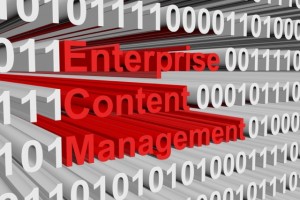While an effective Enterprise Content Management (ECM) strategy takes a holistic approach to managing the flow of data throughout an organization, it is often best understood and addressed in four components:
- Understanding your content
- Multi-channel capture (or data “ingestion”)
- Transformation
- Publishing
Researching these components and mapping out a logical and efficient process for moving from one to the other is the first step in crafting and implementing the right business process management solution.
Understanding Your Content
 If the thought of trying to develop a truly comprehensive list of the types of content your company uses makes you shudder, you’re not alone. Most companies are in the same boat. Although you deal with this data every day, it’s not until you sit down and start to create a list that it hits you how much of it you have and how diverse your “collection” is. Of course, this is why an effective ECM system is so critical.
If the thought of trying to develop a truly comprehensive list of the types of content your company uses makes you shudder, you’re not alone. Most companies are in the same boat. Although you deal with this data every day, it’s not until you sit down and start to create a list that it hits you how much of it you have and how diverse your “collection” is. Of course, this is why an effective ECM system is so critical.
Typically, the best place to start your research is to look at the content organization structures that have evolved organically within your organization. For example, when you examine a shared network drive, you may see that there are high level directories for Human Resources, Contracts and Engineering. Although there may be a significant amount of content that falls outside of these categories, at least you know they are important enough to warrant a place at the top of the hierarchy. And this allows you to start building what can be called “job classifications” or “document classifications.”
From here, you can research each of these classifications further to understand things like how you identify them. For example, with contracts, you may have:
- Contract name
- Contract number
- Parties to the contract
- And many other identifiers
These attributes are used to retrieve the documents so that the information within them can be read, edited, shared, etc.
The final aspect of understanding your content is knowing when it has reached the end of its lifecycle. The rules around storing and disposing of content—or your “retention policies”—vary based on a wide variety of factors including everything from company policy to government regulations, so it’s important to really do your homework here.
At the end of this process you have what is called, very simply, your “document of content.”
Multi-channel Capture
Once you have a detailed understanding of the types of content you need to manage, the next step is to look at the “channels” through which this information moves—both around your organization and into it from the outside world—and the different methods needed for capturing it. The most common channels are:
- Paper
- Fax
- Cloud
- EDI (electronic data interchange)
- Network folders
While channels like paper and fax are rapidly giving way to the others, it’s important to recognize every type used by your organization as you look to move to electronic document management. After you’ve identified and documented your channels, you need to assess the amount of data traveling through each. The relative volumes can impact the architecture of your ECM solution.
Finally, you must understand both who is using the data and how they are using it. This, too, will affect how your ECM system is laid out and the technology it is made up of.
Transformation
Transformation uses the automated “robots” that are a part of workflow management software, along with human review and/or confirmation, to determine how a specific piece of content is dealt with. This may involve:
Filtering – Determining what content should be kept or discarded, for example.
Processing – How data should be combined, separated, etc.
Storing – Where a piece of content should “live” in the system.
Transformation also encompasses the ideas of business process management and business process automation. What is your accounts payable process? What actions does a new hire trigger in human resources? What is the review and approval sequence for contracts?
Every component of ECM is important, but transformation is the first “fork in the road” so to speak – the first decision point in the actual processing of your data. Consequently, it is critical that content transformations be thoughtfully implemented, thoroughly tested and regularly reviewed.
Publishing
The publishing of your content makes it accessible to people within your organization through your intranet or other data sharing framework, and if you choose, the outside world through the internet. Rules you set determine the kind of access (view, edit, etc.) individuals or groups have to specific files or types of files and help keep your data safe and secure.
Also key to the publishing component of ECM is your data retention policy and strategy. As mentioned above, a number of governance, risk and compliance factors must be weighed as you develop your approach. Among the questions you should be asking are:
- How long is each type of your content relevant?
- How much space does it take up on your server?
- Are there government regulations for this type of data and if so what are they?
- What circumstances can arise that require a temporary change in your policy?
- In general, what are the potential negative impacts of retaining this type of content too long or not long enough?
- How does our retention policy affect your staff and your customers or other stakeholders?
Your policy must also address issues such as the appropriate person or people to be automatically notified when content is slated for disposal and the specific steps taken in the disposal process.
Enrolling the Enterprise
At Buddha Logic, we refer to the process of preparing for and implementing an enterprise-wide content management strategy as “Enrolling the Enterprise.” It’s a name that can sound a little formal and intimidating, but when the procedure is tackled logically and sequentially, our clients comment that it is very informative, highly rewarding and actually enjoyable! Nothing feels better than having a clear and complete understanding of what all your data assets are, and confidence that the new system you’ve put into place will ensure that they are all managed properly going forward.
How can ECM help you increase processing speed, reduce error rates, automate repetitive tasks, and increase client satisfaction? A quick call with one of our consultants is all it takes to understand how better content management can impact your organization.
About the Author
Charles Weidman is the President and CTO of Buddha Logic. Charlie has over two decades of experience in the design, development and implementation of enterprise content management, business process management and enterprise resource planning solutions. He founded Buddha Logic with the idea that well-architected digital document capture and management processes are both beautifully simple and powerfully logical. Find and connect with Charlie on LinkedIn.

